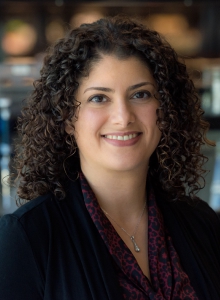Lab Chat: An Interview with Dr. Shomyseh Sanjabi
amfAR grantee Dr. Shomyseh Sanjabi is an assistant investigator at the Gladstone Institute of Virology and Immunology, a collaborating partner of the amfAR Institute for HIV Cure Research at the University of California, San Francisco. On a recent visit to amfAR’s New York office, Sanjabi talked about her early interest in science, her innovative research toward an HIV cure, and the importance of mentoring early career investigators.
 Dr. Shomyseh SanjabiWhat sparked your interest in science?
Dr. Shomyseh SanjabiWhat sparked your interest in science?
In high school, I was really interested in art as well as math and science. I think my interest in math and science came in because my family immigrated to the U.S. when I was 12 from Iran. It was an easier topic compared to history or literature. But I was always very detail-oriented and I loved doing art because of the combination of details and creativity. In fact, I compare science to a painting. The white canvas is the big question. You gather the things you need, and then it’s a beautiful picture when you have an understanding of it.
In my senior year in 1993, my AP biology teacher had a friend who was in a Ph.D. program come and talk to us about genetic engineering. At the time, I just thought that was the most fascinating thing you could ever hear about. It was eye-opening. In fact, I chose to go to UCLA because the school had a microbiology/molecular genetics major.
How did you become interested in HIV research specifically?
At the time HIV/AIDS was all over the news. It was one of the biggest problems in the world. In fact, my teacher asked us to write down where we were going to be in 10 years. I wrote, ‘I’m going to be running my own lab and working on a cure for HIV/AIDS as well as cancer.’ While my Ph.D. and post-doc were in more basic immunology, I was really excited when I landed the opportunity to work for Gladstone Institutes, which focuses on HIV research. This is something that can potentially have a more immediate impact. I started in HIV just a few years ago but have tried to learn and contribute as much as I can.
Could you tell me about the work you are doing in antiviral immunity?
Most pathogens are unable to get past the first early line of defense—the innate immune response. We’re constantly breathing the air, our gut is filled with trillions of bacteria, but yet we’re not sick because we have this innate defense. But if an organism is able to cross this barrier, it has to be recognized as something dangerous. So these innate immune cells will essentially ‘call in the troops,’ which are the adaptive cells that can recognize and kill viruses. How does the communication between the adaptive cells and innate cells happen? How do the innate cells know that the virus is dangerous? We are trying to answer these questions.
My teacher asked us to write down where we were going to be in 10 years. I wrote, ‘I’m going to be running my own lab and working on a cure for HIV/AIDS as well as cancer.’
How will this help us in terms of our search for a cure for HIV?
We have hypothesized that the cells that make up the latent reservoir in the mucosa are different than the cells that we see floating around in the blood. And we know there are reservoirs in the brain, the gut, and the female reproductive tract that appear activated but are not transcribing HIV. Why are these cells in the mucosa staying in a latent state? How do we get those cells out of there so we can mobilize them and kill them? Understanding what happens in the mucosa and how the innate and adaptive immune systems communicate with each other will help answer these questions.
The Institute is working to overcome the main barrier to a cure—persistent reservoirs of virus resistant to antiretroviral therapy. Could you provide us with a progress report?
We’re getting close to figuring out where the reservoir is, and we’re getting close to characterizing it. Now we need to figure out how to reactivate it. However, I don’t think reactivating the reservoir is going to kill those cells. You will need the adaptive arm. It’s easy to find these cells if they are in the blood or spleen but not if they are in the mucosa. So we need to be focusing on how to activate HIV-specific killer T cells to get into the tissues and find the minute amounts of antigen [foreign substances] that are being produced and kill them. Because when the virus is reactivated it may only give a tiny signal that it’s there.
You’re a mentor to many young investigators and recently reviewed proposals for our Mathilde Krim Fellowships. How tough is it for young researchers to find funding?
You have to constantly prove yourself until you’re recognized. It takes a thick skin. One of my post-docs was saying, ‘Well I’m going to submit this grant, but if it doesn’t get discussed, then maybe I shouldn’t be in science.’ I’m like, ‘Are you kidding me? Do you know how many grants I have had that were not discussed?’ You can't take it too personally. It’s important to give young people a chance to get hands-on experience early on. For example, I have an intern in my lab each summer. When I was a freshman at UCLA, my first mission was to find a lab position to fulfill my work-study requirements. I joke that I haven’t left the lab since then!